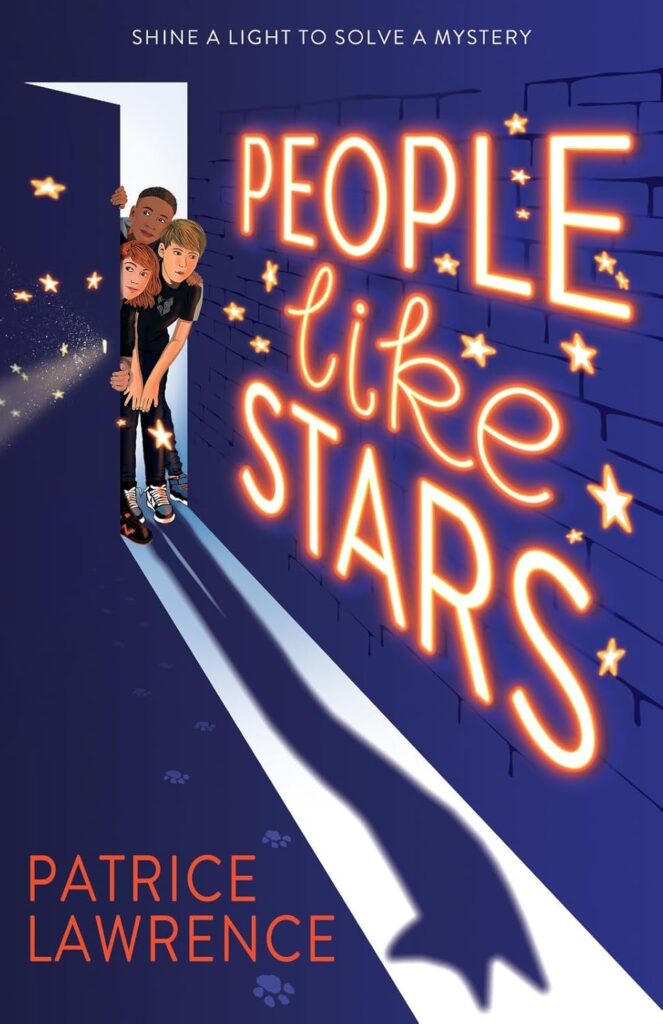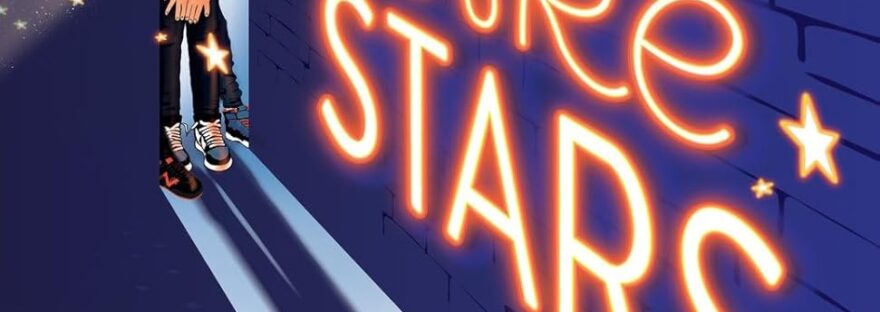By Patrice Lawrence (pub. Scholastic, 2025)
On clear nights, we saw swirls of stars above the trees. I asked Ari how big the sky must be to fit in all those stars. She said that they looked close together to us down on Earth, but really they were far, far apart from each other.
Maybe all these people are like stars. It seems like they’re together, but really they’re alone like me.

People Like Stars follows the lives of three youngsters: 13-year-olds Ayrton, Stanley, and Sen. Each of their families is harbouring a secret, secrets which could be explosive if revealed. But sometimes it’s better for the truth to come out…isn’t it?
The point-of-view character changes each chapter between Ayrton, Stanley, and Sen, giving us a chance to really get to know them as individuals and together. I always enjoy this approach, as it allows us to see characters’ inner thoughts, and often to see how the same situation looks from multiple perspectives.
The first chapter for each character gives us an introduction into their life, their family, and a peek at the issue that they’ll be facing or investigating during the book, offering us an effective overview before the story properly kicks off.
Ayrton was stolen from his mum as a baby. He wasn’t gone long, and was safely returned, but it’s left his mum fearful and smothering. He rarely goes anywhere without her, has his phone location on at all times, and has no friends.
Stanley loves his family (except his twin brother!) but wants to know more about his maternal grandmother, the one no-one will talk about. All he knows is that they’ve had no contact with her for years because she did something terrible.
Sen and her mum have found a place to stay, after a long time of couch surfing and bouncing between rentals. They’re bound by rules so as not to upset their landlady, a mysterious artist who would likely have them out on the street if they mess up.
Their experiences and lives mean that the three kids are all very different; Ayrton is shy and awkward, Stanley is outgoing and friendly, Sen is cynical and reserved. Having the POV change throughout the book means that the three different personalities are well balanced to read.
The chapters themselves are quite short, and very moreish as a result! The story’s pace is true to life but compelling, with breaks in the children’s activities (they still must go to school after all!), and then sudden reveals or escalations that throw them into action, or their plans into disarray.
Going to the same school means that Ayrton and Stanley are brought together quite quickly, and I enjoyed watching how they play off against each other. They both have stakes in the investigation into Stanley’s grandmother, but they also both have things holding them back.
Ayrton has suffered in a way that Stanley can’t really appreciate, and it’s no surprise when the dam eventually breaks late in the story. Although I won’t say it here, I didn’t find the reveal of Stanley’s grandmother to be a surprise – but it’s accompanied by several unexpected twists I didn’t see coming, and thoroughly enjoyed!
There are parallels between what the adults and the children are experiencing; fear, anger, guilt, lies, sadness. It’s easy to think about everything the children have suffered, without remembering that the grown-ups have gone through their own difficulties too, all those years ago.
Ultimately, it comes down to adults trying to do what they think is right in their attempts to protect their families, without recognising that having open discussions with children can benefit both sides – whether it brings people together, or simply provides closure and understanding.
I realise that I’ve written a lot about the characters and the nuance of their situations without getting into the technicalities or the quality of the writing. But that’s simply because it’s so well written that I found myself drawn in, immersed in what these children were going through.
The world building is fantastic; the settings feel genuine, and it’s great to see libraries getting some love (even if Ayrton having to explain microfiche makes me feel old!). The characterisations of even the minor characters feels authentic, with a full range of personalities that keeps things interesting.
Sometimes in books like these, the parents or siblings can feel like carbon copies, but that’s not the case here. Each have their own feelings and reactions to the situations and, as someone with twin brothers, I must say that Stanley and Oliver’s interactions feel spot on!
There is a warmth to the story, despite the hardships, that works well with the often raw and complicated emotions. It made my heart ache to watch the blossoming friendships come under strain, but the characters’ growth – no matter how painful – was necessary, and definitely well-earned.
People Like Stars is so much more than just a story about family. This poignant tale of friendship, secrets, and the lies we tell to protect ourselves and others is by turns saddening, maddening, joyous, and never anything less than heartfelt.
If you’ve never read one of Lawrence’s books, then this is a good place to start – and then make sure that you go read her other fantastic works afterwards!
If you want to explore the mystery, you can grab a copy of People Like Stars at the link below.
(Disclosure: If you buy books linked to our site, we may earn a commission from Bookshop.org, whose fees support independent bookshops.)
Looking for more stories about family? Check out some of our previous book reviews here.

